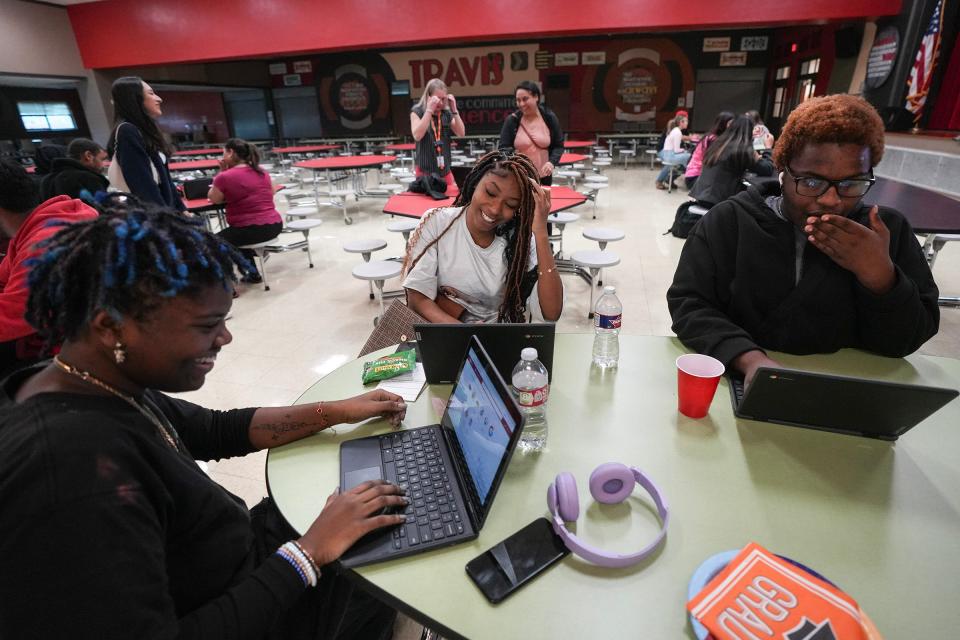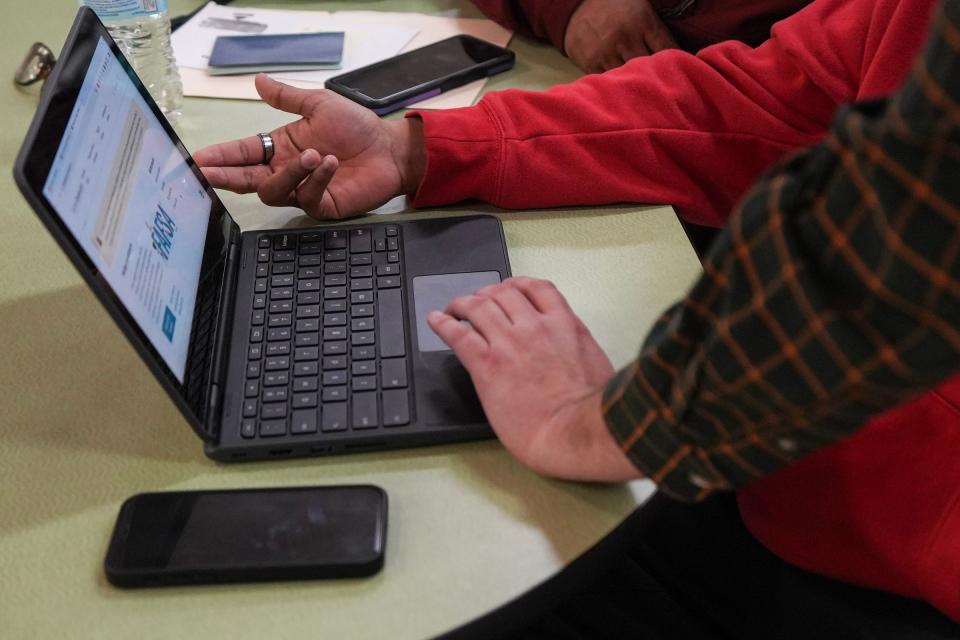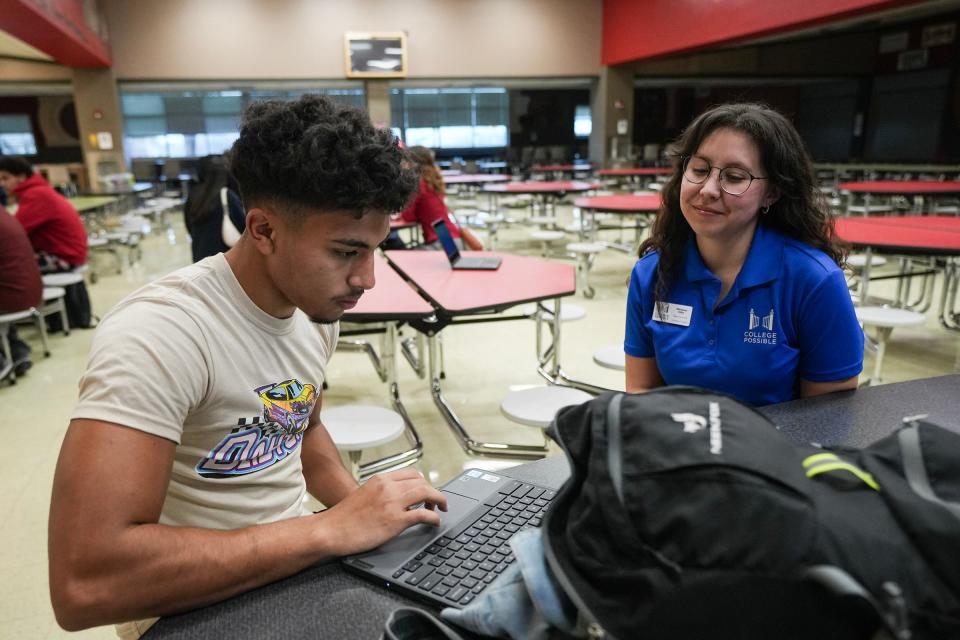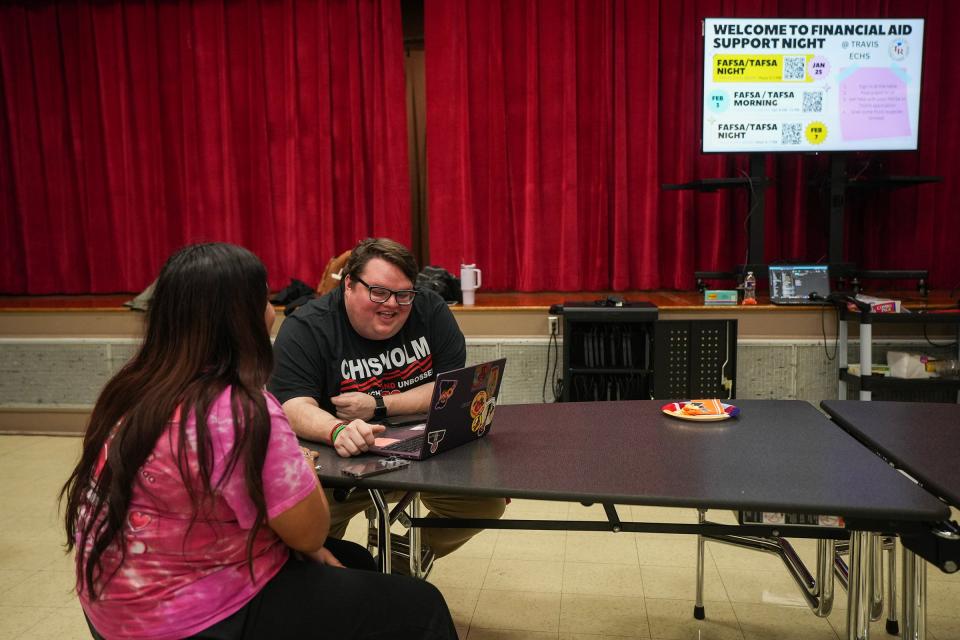'Significant crunch in the timeline': FAFSA delays impact Austin area high school seniors
On a recent Wednesday evening at Travis Early College High School, families sat hunched over Chromebooks, staring at the glowing screen and poring over financial aid forms. A SZA song played over the speakers as 18 Pizza Hut boxes, assorted cookies and a plate of fresh fruit beckoned from the back of the room.
Parents and students like Jacob Morales, a senior, had come to the high school cafeteria to get help filing out their college financial aid forms — a long and complicated process that this year has come with unexpected hiccups.
"I'm just trying to take it step-by-step," said Morales, who's interested in going to school for welding. "It's maybe a little confusing and a little struggle here and there."
Every year, Opportunity Austin, a regional economic development organization, hosts more than 40 “FAFSA Completion Events” across Central Texas from October to March to help students and parents navigate the Free Application for Federal Student Aid forms in English and Spanish. The paperwork is necessary to access federal student financial aid, such as Pell Grants, that make college affordable for millions of families.
This year, however, organizers didn't start the help sessions until January because the federal aid application didn't open until the end of December.
The new form is streamlined ― lessening the number of questions from more than 100 to as little as 18 for some applicants ― but the changes have also created bugs and delays in the online application this year, further complicating what's already a stressful process for families and truncating the normal timelines for colleges. The rollout of the updated system has especially created hurdles for students whose parent doesn't have a Social Security number.

The delays stem from the rollout of the 2021 FAFSA Simplification Act, which tasked the U.S. Education Department with streamlining the form, expanding who can receive aid and revamping need-analysis formulas to be more reflective of families’ ability to pay.
More than two dozen Republican members of Congress wrote to the Government Accountability Office on Jan. 24 expressing worries that the delayed FAFSA rollout would cause students who are most dependent on financial aid "to give up and not pursue postsecondary education." The FAFSA typically opens Oct. 1. This year, it soft-launched in late December, and more than 3.1 million applications were submitted in the first month alone, the department said.
And six weeks after its launch, not all students have been able to submit their applications. Students of parents without Social Security numbers cannot complete the form, a glitch that has been on the Federal Student Aid’s issues alert list since Jan. 4.
How are students affected?
For students, the delay means less time to complete their forms. That's a challenge particularly because FAFSA takes so long to complete, said Elizabeth Chang-Yen, lead counselor at Austin's Eastside Early College High School.
"If they're having difficulty plugging in that information, it takes them a while," Chang-Yen said. "They can't just do it in one sitting."
For many students, that means a delayed choice process, she said. Students' college decisions heavily weigh financial considerations, and they won't know how much aid they can count on from the federal government until their FAFSA forms are processed.
"For some of them, that means they don’t even know if they'll be able to afford college," Chang-Yen said.

Forming relationships and cultivating trust are important when supporting immigrant families affected by the delays, said Abigail Caldwell, an adviser with the University of Texas Advise TX program, which places college advisers in Title One high schools.
“I can't tell them when they (the parent) will be verified, but that when they are finally, I'll be there to help them through the process,” Caldwell, who advises families at Travis High, said at Wednesday's event. “We've also just made ourselves uber available.”
Almost every student Xavier DeGrate spoke to Wednesday would be a first-generation college student, he said. DeGrate, is a program director at Communities in Schools of Central Texas and works to help support Black and Latino men. DeGrate has been helping parents without Social Security numbers prepare to file their applications once the glitch is fixed.
“We're trying to work out some loopholes that we have right now, but I haven't once seen it actually work,” he said. “It was never supposed to be a problem in the first place.”
Ruth Rodriguez attended the event at Travis High and hopes it'll all be worth it, she said through an interpreter. The process is really hard, but she wants her son, José, to have opportunities she didn't have, Rodriguez said.
José is interested in studying business and working for Tesla, he said.
Mireya Solis, a senior at the high school, said the school called her about the event, and she came with her father seeking help completing the form. She said she hasn't been affected by the delays.
“It's been pretty quick; we just needed a little help,” Solis said. “It’s a lot of questions, a lot of questions about residency, a lot of Social Security stuff and a lot of stuff from our background.”
Solis plans to attend Austin Community College to become a dental hygienist.

How are universities affected?
The delays notably shorten the time most universities would have to determine their awards, and for students to make decisions, said MorraLee Keller, a strategic programming director at the National College Attainment Network, a postsecondary advocacy nonprofit that also runs FAFSA workshops in Austin.
“It's going to put a significant crunch in the timeline this spring that students will have to get award letters and make decisions,” Keller said. “The waiting is difficult on everyone.”
On Feb. 5, the U.S. Education Department announced it was deploying various supports to schools and students to complete the financial aid forms and to universities to prepare to process them, with a particular focus on lower-resource schools. This includes $50 million in federal funding for nonprofits that specialize in financial aid and sending federal workers to colleges that need the additional help. The department also said it would send test versions of the Institutional Student Information Records to universities by Friday and take additional steps to make records processing more efficient.
Concordia University Texas has been working directly with families to help them navigate application challenges but hasn't received student data yet, said KC Pospisil, vice president of academic operations.
“That is the missing piece,” she said.
Colleges and universities are expected to receive student financial aid applications in the first half of March, according to the Education Department.
The delays have been challenging, but Pospisil hopes the changes let more students qualify for federal aid — a “huge deal” to Concordia Texas, she said.

What could be the effect of the new FAFSA?
Educational support ensures “the economic vitality of the region through a skilled labor force," said Stacy Schmitt, Opportunity Austin spokeswoman.
“If you look at our success in the last five years, we’ve worked with 83,000 students, which yielded $1.1 billion in scholarships,” Schmitt said. “I think a shorter form, a more comprehensive form is probably going to be break down some of those barriers, and so those numbers I'm hoping increase.”
The Education Department said almost 4 million forms have been successfully submitted thus far. Texas is expected to receive over 51,000 more Pell Grant recipients under the new form. About 21.7% of Texas high school seniors this year have submitted a FAFSA as of Feb. 2, National College Attainment Network data show.
The more students who complete financial aid applications, the more students likely will pursue college, DeGrate told the American-Statesman as students around him worked on their forms at Travis High. For DeGrate, this mission is especially meaningful.
“I’ve got a brother in prison right now, and he had more potential than just about anybody else that I know,” DeGrate said. “That extra hand, that intentional, ‘I'm going to reach out and help you’ — I see my brother in all these students. … it’s personal for me.”
Keller said the waiting period for results is new compared with previous years. But she expects the new FAFSA will ultimately be positive, and she'd recommend that parents be patient and stick it out.
“Our messaging to students and families, would be, ‘Hey, don't give up on the system,’” she said. “Hang in there and keep doing it. Keep trying until the system works for you.”
This article originally appeared on Austin American-Statesman: How FAFSA delays, glitches are affecting Austin immigrant families

